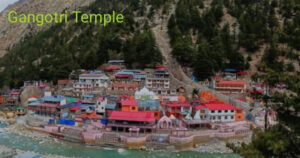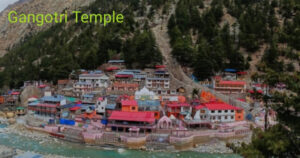Nestled amidst the majestic peaks of the Himalayas, Gangotri Temple is one of the most revered shrines in India. Dedicated to Goddess Ganga, it holds immense significance in Hinduism as the origin point of the sacred River Ganges. Located in the Uttarkashi district of Uttarakhand, this temple attracts thousands of pilgrims and tourists every year, especially as part of the Char Dham Yatra. The spiritual aura, combined with the awe-inspiring beauty of the surrounding landscape, makes Gangotri a must-visit for those seeking both devotion and adventure.

1.History of Gangotri Temple
Gangotri Temple has a rich history deeply rooted in Indian mythology. It is believed to have been built by the Gorkha General Amar Singh Thapa in the early 18th century. However, the legend of Gangotri goes back much further. According to Hindu epics, it was here that King Bhagirath meditated to bring the river Ganga to Earth from the heavens. His penance pleased Lord Shiva, who caught the mighty Ganga in his locks to temper her descent. The current temple structure has undergone several renovations, particularly after natural calamities, yet it retains its spiritual essence and historical charm.
2. Gangotri Temple: Spiritual Significance
The Gangotri Temple holds a special place in the hearts of Hindus due to its association with the Ganges, a river considered the lifeline of Indian culture and spirituality. According to legend, the Ganges was sent to Earth to purify the souls of humanity. Pilgrims believe that a visit to Gangotri and a dip in the holy waters near the temple can cleanse sins and lead to salvation. The temple is also an essential stop on the Char Dham Yatra, which includes Yamunotri, Kedarnath, and Badrinath, completing a pilgrimage that many Hindus aim to undertake at least once in their lives.
3.Architecture of Gangotri Temple
The architecture of Gangotri Temple reflects simplicity yet exudes a divine charm. Built from white granite stones, the temple stands at an elevation of 3,100 meters above sea level, blending naturally with its surroundings. The sanctum houses the idol of Goddess Ganga, adorned with jewelry and flowers. The temple’s design incorporates traditional North Indian temple architecture, with a small dome and spire typical of the region. What makes the temple even more special is its setting – surrounded by deodar and pine trees, and flanked by the Bhagirathi River, creating a perfect blend of spirituality and nature.

4.Pilgrimage and Religious Practices
The temple opens for pilgrims in May and remains accessible until the onset of winter in late October or early November. During these months, thousands of devotees make their way to Gangotri to offer prayers and perform rituals. The most important festival celebrated here is Ganga Dussehra, which marks the day when Goddess Ganga descended to Earth. Pilgrims also participate in other ceremonies like Aarti and offering prayers to their ancestors. The temple follows the tradition of closing its doors for the winter months, during which the idol of Goddess Ganga is moved to the village of Mukhba, where it is worshipped until the temple reopens in spring.
5.The Gangotri Trek and Nearby Attractions
For the adventurous soul, a pilgrimage to Gangotri offers much more than spiritual fulfillment. The trek to Gaumukh Glacier, the origin of the Ganges, is one of the most popular treks in the region. The trek, which starts from Gangotri, takes you through rugged terrains, dense forests, and breathtaking landscapes, culminating at the glacier. Gaumukh is revered as the “mouth of the cow” from where the holy river emerges. Besides Gaumukh, pilgrims can visit nearby attractions like Kedarnath, Badrinath, and Yamunotri, completing the sacred Char Dham circuit. The scenic beauty, combined with the spiritual energy of the area, makes the journey unforgettable.

6.Best Time to Visit
The best time to visit Gangotri Temple is from May to June and September to November. During these months, the weather is pleasant, making the journey to the temple and nearby treks comfortable. The region remains closed during the harsh winter months due to heavy snowfall, with the idol being transferred to a lower altitude. Travelers should also consider avoiding the monsoon season, as the area becomes prone to landslides and road blockages. The temple is easily accessible by road from key towns like Rishikesh and Uttarkashi, with several transport options available for both pilgrims and tourists.
7.Cultural and Environmental Significance
The Ganges River, which originates from Gangotri, is not only a spiritual symbol but also a vital lifeline for millions of people across India. The river is an integral part of Indian culture, influencing religious practices, agriculture, and even literature. The town of Gangotri itself is steeped in cultural heritage, with traditions that have been passed down for generations. However, the environmental significance of the region cannot be overlooked. The melting glaciers, changing weather patterns, and pollution of the Ganges are serious concerns. Conservation efforts are crucial to preserve both the ecological balance and the cultural sanctity of Gangotri.
Conclusion:
Gangotri Temple is more than just a religious destination; it is a place where faith, history, culture, and nature come together. Whether you visit as part of the Char Dham Yatra or as a curious traveler seeking tranquility in the lap of the Himalayas, Gangotri offers an experience that transcends the ordinary. From its mythological significance and sacred rituals to the stunning landscapes surrounding the temple, a journey to Gangotri is as much about inner reflection as it is about exploring the majestic beauty of nature. So, if you’re planning a spiritual or adventure-filled trip, Gangotri should undoubtedly be on your list.
By understanding the history, significance, and beauty of Gangotri, visitors can fully appreciate the temple’s spiritual importance and the need to preserve its natural environment. Whether seeking salvation, serenity, or the thrill of the Himalayas, Gangotri Temple offers something unique for everyone.
FAQ:
1.What is special about Gangotri Temple?
2.Which God is in Gangotri Temple?
3.How long is Gangotri Temple Trek?
4.Is Gangotri Temple accessible by car?
5.Gangotri Temple History in Hindi
6.Gangotri river map
7.Gangotri river origin
8.Gangotri river in which state
9.Who built Gangotri temple
10.Gangotri Temple UPSC

